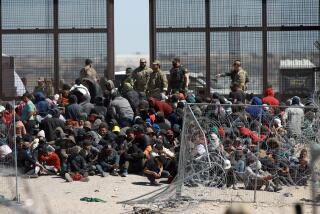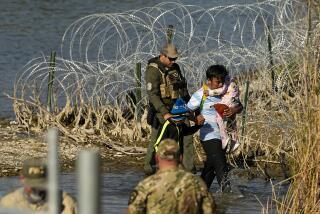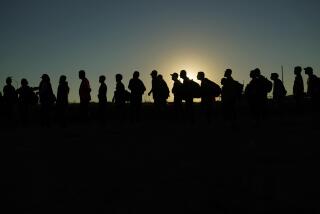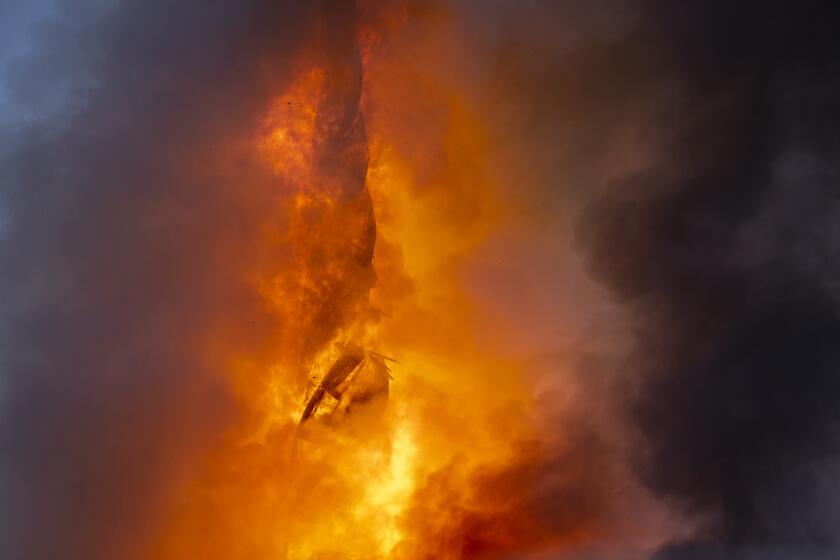Asylum seekers blocked at Texas border bridges say Mexican officials are demanding money to let them pass
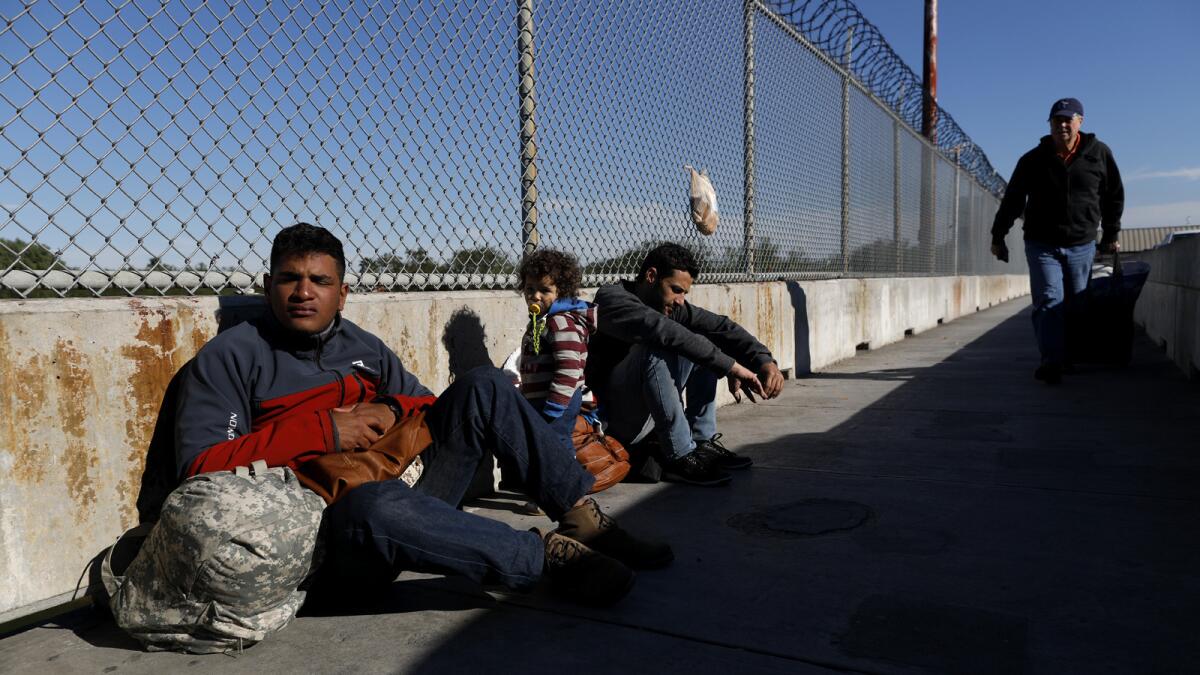
Asylum seekers funneled to bridge crossings at the Texas border are being blocked from approaching the U.S. side, forced onto waiting lists overseen by Mexican officials.
The asylum seekers and immigrant-rights advocates say that has put them at risk of extortion, discrimination and deportation, with many telling of Mexican officials demanding money to let them pass and of watching others, further down the list, cross ahead of them.
In Matamoros, a city across from Brownsville, Texas, the list is kept on a clipboard in an opaque blue plastic case on the newer of two border bridges. Though Mexican officials maintain the list, U.S. officers decide how many asylum seekers cross. An individual familiar with the Mexican immigration system who asked not to be identified for safety reasons said U.S. officials choose who crosses based on nationality and other characteristics.
Last week, Mexican immigration officials notified four asylum seekers camped at the foot of the bridge for more than a month that it was their turn to cross. They had been near the top of the waiting list for days but had watched others jump ahead of them. Now they said teary goodbyes to about 20 migrants they had been staying with on cots under tarps.
Mexican officials escorted the four — a pregnant woman, her boyfriend, a mother and her 16-year-old son — to a U.S. customs officers’ station at the center of the covered bridge.
“How many are you, and from what countries?” one of the U.S. officials asked in Spanish.
The migrants identified themselves, and the U.S. officials counted aloud: two Cubans, two Guatemalans. Mexican officials nodded. Then they allowed the four to enter the U.S.
U.S. law says immigrants can present themselves to request asylum at border crossings or inside the country after entering illegally. But as thousands of Central Americans approached the border this month, President Trump announced that those crossing illegally would be denied asylum. This week, a federal judge in San Francisco blocked that asylum ban.
But the judge’s ruling didn’t address the administration’s efforts to stop asylum seekers at southern border bridges. U.S. Customs and Border Protection officials say they have run out of space to process them at border holding areas, most of which they said house fewer than a hundred people.
The agency has stationed officers at bridge midpoints to prevent asylum seekers from entering the U.S. The migrants must add their names to waiting lists in Mexico, a process U.S. officials call “queue management.”
A list was first used two years ago in Tijuana, prompting immigrant advocates to sue in California federal court, arguing the process illegally blocked asylum seekers. With the lawsuit pending, U.S. immigration officials expanded the system to busy crossings in Arizona and Texas.
As of last week, waiting lists were being used at all major crossings in Texas, said Rick Pauza, a Laredo, Texas-based spokesman for U.S. Customs and Border Protection.
Across the border from El Paso, Mexican officials in Ciudad Juarez cleared 300 migrants from border bridges last week, sent them to shelters and created a waiting list, said Shaw Drake, a lawyer with the American Civil Liberties Union of Texas. Asylum seekers’ numbers on the list were written in marker on their arms.
“They’re creating the circumstances under which that’s necessary,” said Drake, adding that about 20 of the asylum seekers were being admitted to the U.S. daily from Juarez. “It’s illegal to be turning these people away and making them wait.”
To the east, where Texas’ Rio Grande Valley borders the Mexican state of Tamaulipas, U.S. and Mexican immigration officials launched a joint campaign in September against cartel violence and corruption. But U.S. authorities delegated management of asylum seeker waiting lists to Mexican counterparts. The lists are not made public, and they are not monitored by U.S. officials, Customs and Border Protection said.
In Matamoros last week, officials from Grupos Beta, the humanitarian arm of Mexican immigration services, could be seen using the list to record the names of 80 asylum seekers. Two weeks before, the list contained 165 names, said migrants who saw it. It was unclear how many of those removed from the list had been allowed to cross. Mexican officials refused requests to review it.
Officials at Mexico’s National Institute of Migration office at the city’s new bridge declined to comment, as did the institute’s Grupos Beta Matamoros. Institute officials in Mexico City did not respond to requests for comment, including about extortion allegations.
U.S. Customs and Border Protection said it “processes undocumented persons as expeditiously as possible,” and denied it was involved in selecting who enters from the lists.
“Nationality has absolutely no bearing on the processing” of asylum seekers, and those on the lists are “processed on a first-come, first-serve basis,” the agency said.
The agency said it “does take into consideration persons with medical emergencies, unaccompanied alien children, the disabled, and gives priority as we can, bearing in mind the day-to-day availability of resources, case complexity, holding space, port volume and enforcement actions.”

Jessica Zamora, an 18-year-old Cuban who is seven months pregnant, was still waiting at the foot of the Matamoros bridge last week, more than 25 days after U.S. officials allowed her mother and 13-year-old brother across. The officials didn’t consider her part of the same family, Zamora said. Two other pregnant women were also waiting to cross.
“We wait here while others pass because we don’t have money,” Zamora said.
Mexican immigration officials in Matamoros said they try to limit the number of asylum seekers waiting at the new bridge to 10, ferrying the rest to a shelter across town, but the number swelled recently as migrants refused to leave, afraid of missing a chance to cross.
An additional 39 asylum seekers waited at the shelter, including some families stuck there for more than a month. Their temporary Mexican visas had expired, and they worried they could be deported.
“There are weeks they don’t call anyone” to cross, said asylum seeker Yoveni Torres, 37. His family left Nicaragua after being persecuted for joining the Catholic resistance to the country’s authoritarian government, he said. He was still waiting this week after a month at the shelter with his wife and three children.
Two dozen migrants from Central America, Cuba, Africa, Brazil, Colombia, Ethiopia, Mexico, Russia and Venezuela camped at the foot of the bridge last week without food, water or medical care beyond occasional visits by the Mexican Red Cross, even as temperatures dipped to freezing.
They said immigration officials had failed to secure the bridges, leaving them vulnerable to extortion. When they complained, Mexican immigration officials threatened to force them to leave, including when they were being interviewed by The Times.
“See how they talk to us? ‘Go’ like dogs,” said Yaneisi Jinarte, a teacher from Cuba.
Jinarte said she complained to U.S. immigration officials. Others said they had tried, but Mexican officials barred them from reaching the bridge’s midpoint.
Two other Cuban asylum seekers said Mexican immigration officials demanded they pay to cross the city’s older bridge this fall. They refused and were still waiting to cross last week.
Their claims were being investigated, according to the Mexican individual who requested anonymity. He said that immigrants are not supposed to cross on the older bridge, where their names are not added to the list, and that U.S. officials should stop allowing them to sneak onto the bridge and cross. U.S. Customs and Border Protection said it was up to Mexican officials to manage the flow of asylum seekers at the bridges.
Cuban asylum seeker Elvis Gonzalez Rodriguez said that when he arrived at the old bridge last week, a uniformed Mexican immigration official demanded he pay $1,000 to cross. Gonzalez, 23, refused, and the official made him leave. At the newer bridge, a backpack containing his passport and cash was stolen, he said. He returned to the old bridge and was forced off by Mexican immigration officials three more times.
“There’s a lot of corruption here. It’s the responsibility of Mexican officials to protect immigrants. I want to come the correct, legal way,” the electrician from Havana said as he sat on the old bridge again on Nov. 14, a few feet from two U.S. customs officers.
They need to help us. They need to know about the corruption, how it’s a business to pass here.
— Cuban asylum seeker Elvis Gonzalez Rodriguez
He said the U.S. officials should help asylum seekers and investigate what’s happening a few feet south of them on the bridge.
“They need to help us. They need to know about the corruption, how it’s a business to pass here.”
Another Cuban asylum seeker said a uniformed Mexican immigration official demanded $500 to get her across the old bridge after she arrived at Matamoros airport in mid-October. She said she gave the official her passport and $300 at the airport, then got nervous.
“He didn’t seem trustworthy, so I left,” said Rosa Maria, 50, who asked to be identified by first name because she feared for her safety.
She said Cuban asylum seekers have called her cellphone after crossing the old bridge to say they paid Mexican officials $100 to $300 each to bypass the list.
U.S. volunteers and immigrant advocacy groups alerted Mexican authorities that asylum seekers have been forced to pay to cross the bridge since June.
“They are. I know that’s a fact,” said Michael Seifert, an ACLU border advocacy strategist in Brownsville. “It’s only gotten worse. It’s gotten more expensive. The Cubans are targeted because they have money.”
He said African immigrants are forced to wait weeks because “they don’t speak enough Spanish to understand the bribe.”
Asylum seekers from Cameroon said Mexican officials in Matamoros turned them away this month and told them the U.S. was not accepting more Africans. Michael Randy said he asked U.S. customs officers at the bridge, who rejected the claim and assured him African asylum seekers were still being accepted. Mexican officials are investigating, according to the individual who requested anonymity.
Randy, 30, said he fled Cameroon after police fatally shot his younger brother, raped his wife in front of him and then burned the home they shared with their 2- and 3-year-old daughters. He hasn’t heard from his family since. Randy said he was imprisoned and tortured for 77 days, then fled the country.
In Matamoros, he said Mexican officials forced him off the old bridge, but not Cuban asylum seekers who were behind him on the list at the new bridge but managed to cross the old bridge before him. “That shows there is something wrong,” he said.
Another Cameroon migrant suffered a tropical disease that can cause blindness but had to wait a month before U.S. volunteers interceded last week; he was then allowed to cross and receive treatment at a hospital.
“It’s not fair,” Randy said Nov. 12 as he stood at the new bridge eating a donated chicken dinner, wondering when he would cross. “I could stay for a month — there’s no certain time.”
Cuban asylum seeker Leonardo Mederos, 30, said he paid a smuggler $4,000 to get him to a border bridge to the west in Reynosa, a Gulf cartel stronghold, where the smuggler assured him he would be able to cross and join relatives in Miami.
“He told me if I paid, nothing would happen,” Mederos said at the Brownsville bus station last week. Mederos crossed Sept. 28 and was released from immigration detention this week with a notice to appear in immigration court.
Christina Patiño Houle of the nonprofit Rio Grande Valley Equal Voice Network said Mexican officials at times close the bridges with gates, shutting migrants out.
“These are incredibly dangerous areas where these individuals are waiting for days and weeks to enter the bridge. We sometimes have pregnant women, women with toddlers, who are sent back into territories that are managed openly by cartels,” she said. “It just does not reflect a genuine effort to allow people to come to the United States and seek asylum.”
In response to questions about whether Mexican officials were charging asylum seekers to cross bridges and turning African asylum seekers away, U.S. Customs and Border Protection said: “Mexico is a sovereign nation, and our authorities do not cross international boundaries. Actions of Mexican officials, or people in Mexico, should be addressed to the government of Mexico including any actions taken on the Mexican side of bridges and in the border cities of Mexico.”
molly.hennessy-fiske@latimes.com
More to Read
Start your day right
Sign up for Essential California for news, features and recommendations from the L.A. Times and beyond in your inbox six days a week.
You may occasionally receive promotional content from the Los Angeles Times.

